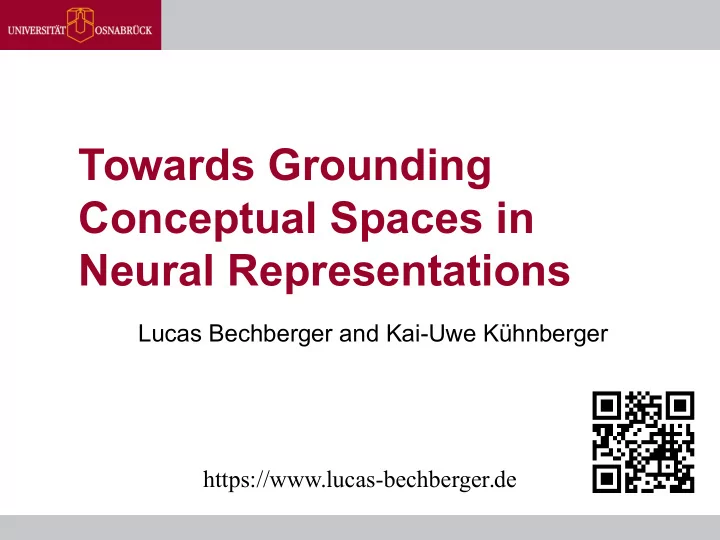

Towards Grounding Conceptual Spaces in Neural Representations Lucas Bechberger and Kai-Uwe Kühnberger https://www.lucas-bechberger.de
The Different Layers of Representation ∀ x :apple ( x )⇒ red ( x ) Symbolic Layer Formal Logics Geometric ? Conceptual Layer Representation Sensor Values, Subsymbolic Layer [0.42; -1.337] Machine Learning Towards Grounding Conceptual Spaces in Neural Representations / Lucas Bechberger 2
Dimensions & Domains Quality dimensions Different ways stimuli are judged to be similar or different Interpretable by a human E.g., temperature, weight, brightness, pitch Domain Set of dimensions that inherently belong together Color: hue, saturation, and brightness Distance in this space is inversely related to similarity Geometric betweenness represents semantic betweenness Concepts: regions in this space Towards Grounding Conceptual Spaces in Neural Representations / Lucas Bechberger 3
Example: The Color Domain https://en.wikipedia.org/wiki/HSL_and_HSV#/media/File:HSL_color_solid_dblcone_chroma_gray.png Towards Grounding Conceptual Spaces in Neural Representations / Lucas Bechberger 4
Towards A Thorough Implementation Symbolic Layer Manually define regions Conceptual Layer Manually define dimensions representation learning Subsymbolic Layer Towards Grounding Conceptual Spaces in Neural Representations / Lucas Bechberger 5
InfoGAN – Architecture Information Maximizing Generative Adversarial Networks x ? D z c G G(z) c X. Chen et al., “InfoGAN: Interpretable Representation Learning by Information Maximizing Generative Adversarial Nets”, Advances in Neural Information Processing Systems, 2016 Towards Grounding Conceptual Spaces in Neural Representations / Lucas Bechberger 6
InfoGAN – MNIST Results Three latent variables Categorical (10 classes) Continuous (uniform) Continuous (uniform) X. Chen et al., “InfoGAN: Interpretable Representation Learning by Information Maximizing Generative Adversarial Nets”, Advances in Neural Information Processing Systems, 2016 Towards Grounding Conceptual Spaces in Neural Representations / Lucas Bechberger 7
Domains and InfoGAN Domains in CS framework Latent Space of InfoGAN Interpretable dimensions Tends to be the case Distance-based notion of Smoothness assumption semantic similarity Geometric betweenness Interpolations in latent represents semantic space describe a betweenness meaningful morph Towards Grounding Conceptual Spaces in Neural Representations / Lucas Bechberger 8
Our Proposal Use InfoGAN to learn dimensions of “difficult” domains For starters: shape domain Hyperparameters Number of latent variables → as few as possible, as much as necessary Type of latent variables → continuous (i.e., uniform or Gaussian) Make sure that we learn new dimensions Pre-select training data (if possible) Additional term in loss function: correlation to other dimensions Towards Grounding Conceptual Spaces in Neural Representations / Lucas Bechberger 9
First Preliminary Results Data set of right-angled triangles, rectangles, and ellipses 2 continuous varibles (uniform distribution), 500 epochs Towards Grounding Conceptual Spaces in Neural Representations / Lucas Bechberger 10
Towards A Thorough Implementation Symbolic Layer Manually define regions clustering Conceptual Layer Manually define dimensions representation learning Subsymbolic Layer Towards Grounding Conceptual Spaces in Neural Representations / Lucas Bechberger 11
Overall Envisioned System Subsymbolic layer Conceptual layer Symbolic layer HSB apple color domain banana ANN shape domain Towards Grounding Conceptual Spaces in Neural Representations / Lucas Bechberger 12
Thank you for your attention! Questions? Comments? Discussions? https://www.lucas-bechberger.de
Recommend
More recommend